
Irradiated Dimes
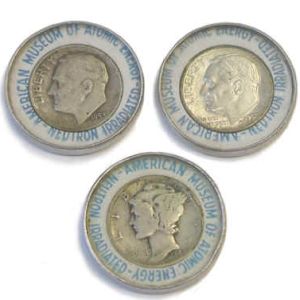

One of the more interesting encased coin is the Irradiated Dime
. Irradiated dimes were created as a way to demonstrate atomic energy principles and as a souvenir. A visitor to the American Museum of Atomic Energy could place a dime from their pocket in to the "dime irradiator", where it was subjected to radiation. The coin was returned in a plastic encasement.
The original pieces were encased in a round 25mm holder with a rolled rim and a plastic convex cover over the dime. The reverse of the dime does not show through the back of the encasement making collecting by mint mark impossible without removing the coin.
The dimes were prepared ahead of time or visitors were allowed to supply their own dime and have it irradiated. The prepared coins were encased in a circular holder of aluminum with a plastic cover protecting the dime. The inside edge of the dime, underneath the cover, was a label that read "American Museum of Atomic Energy - Neutron Irradiated" or "Oak Ridge National Laboratory - Neutron Irradiated." The dime went into the chamber, was irradiated and came out. It's radioactivity was detected with a Geiger counter. When sealed the holder and the dime were a finished souvenir.
However since the visitor could supply the dime, there is a wide variety of dates available for encased irradiated dimes. the irradiator was build in the 1950's so Roosevelt dims were most common, however many Mercury (Winged Liberty) dimes were irradiated as well. There are collectors who collect these encased dimes by date.
One factor to take into account is that with our very sophisticated equipment it is impossible to tell if the dime is original and has been irradiated. The coins were easily removed and spent by many a young person with an eye to their sweet tooth than to historical significance.
The Irradiated dime was produced from 1949 to 1954. The American Museum of Atomic Energy gave out 250,000 souvenir samples. By 1967, the number exceeded one million. The program ended when the US Mint ceased making silver dimes in 1964. In 1965, the dimes were made out of nickel clad copper. For a period of time, the Museum purchased rolls of dimes and searched them for silver dimes to keep the popular program going.
The Oak Ridge Graphite Reactor was during the 1950's the leading source for radionuclide's. The availability of radionuclide's revolutionized medicine and other branches of science. Radionuclides were produced in several ways, but neutron activation was perhaps the most important. In order to demonstrate this process the American Museum of Atomic Energy in Oak Ridge, Tennessee built the dime irradiator. It provided a dramatic demonstration of neutron activation.
At the time that the dime irradiator was in operation, the Museum was managed by the Oak Ridge Institute for Nuclear Studies (ORINS). ORINS is now Oak Ridge Associated Universities (ORAU).
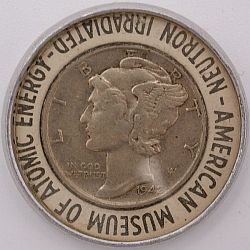
1942 Mercury Head dime encased after irradiation at Oak Ridge, TN. Obverse reads: NEUTRON IRRADIATED - AMERICAN MUSEUM OF ATOMIC ENERGY -
with black text. Encased in steel disk 1.03 inches in diameter with a plastic cover.
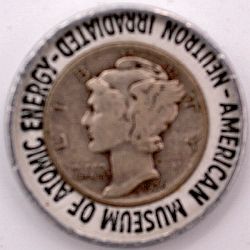
1936 Mercury Dime encased after irradiation at Oak Ridge, TN. Obverse reads: NEUTRON IRRADIATED - AMERICAN MUSEUM OF ATOMIC ENERGY -
with black text.
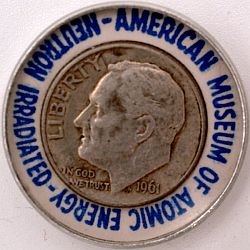
1961 Roosevelt dime encased after irradiation at Oak Ridge, TN. Obverse reads: NEUTRON IRRADIATED - AMERICAN MUSEUM OF ATOMIC ENERGY -
with navy blue text. Encased in steel disk 1.03 inches in diameter with a plastic cover.


1963 Roosevelt dime encased after irradiation at Oak Ridge, TN. Obverse reads: NEUTRON IRRADIATED - AMERICAN MUSEUM OF ATOMIC ENERGY -
with navy blue text. Encased in steel disk 1.03 inches in diameter with a plastic cover.
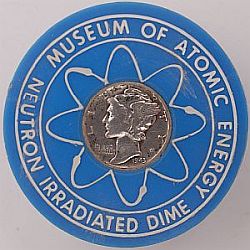
1943 Irradiated dime in blue plastic holder. Obverse reads: "AMERICAN MUSEUM OF ATOMIC ENERGY / NEUTRON IRRADIATED DIME" a neutron orbiting the dime is also depicted.
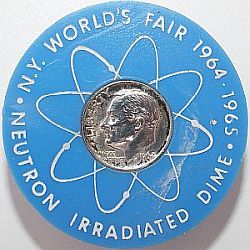
1964 irradiated dime. Obverse reads: "N. Y. WORLD'S FAIR 1964 • 1965 / NEUTRON IRRADIATED DIME" a neutron orbiting the dime is also depicted.
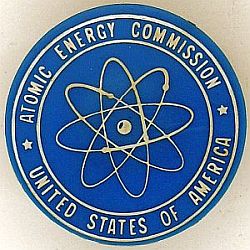
This is a typical reverse for the plastic style irradiated encased.

This is a typical steel encasement for the irradiated dimes.
Above are two plastic encased irradiated dimes. One from 1937 the other a 1964. Note that the first is from the "Museum of Atomic Energy" while the second is from the "1964 - 1965 World's Fair". The colors are almost identical. The difference here is simply my photography skills. The plastic disk were substituted at some point for the steel discs. The legend changed for the exhibit at the N.Y. World's fair. There are several other differences between the "Museum" and "World's Fair", notably the white rings on the museum pieces
1954 press release from the American Museum of Atomic Energy:
Quote taken from ORAU - complete story at Orau.org
Home | Articles | Varieties | Coin Links | About | Terms of Use
Site Copyright 1999-2021 by Bruce Perdue Email: Webmaster All Rights Reserved ©Copyright Bruce Perdue